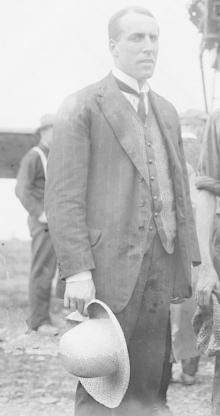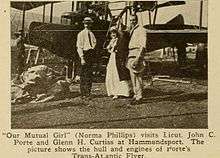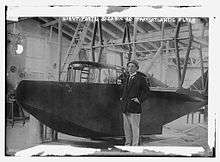John Cyril Porte
| John Cyril Porte | |
|---|---|
 Porte on 22 June 1914, day of the naming ceremony for Wanamaker's America | |
| Born |
26 February 1884 Bandon, County Cork, Ireland |
| Died |
22 October 1919 (aged 35) Brighton, England |
| Cause of death | Pulmonary tuberculosis |
| Nationality | British |
| Occupation |
Inventor Aviator Company director |
| Known for |
Navigation Air racing Transatlantic flight Seaplane Experimental Station Anti-submarine warfare Flying boats |
| Religion | Church of Ireland (Anglican) |
|
Military career | |
| Allegiance |
|
| Service/branch |
|
| Years of service | 1898-1911, 1914-1919 |
| Awards |
Order of St Michael and St George Navy Distinguished Service Medal (United States) |


Colonel John Cyril Porte CMG FRAeS RN (26 February 1884 – 22 October 1919) was a flying boat pioneer associated with the World War I Seaplane Experimental Station at Felixstowe.[5]
Biography
Porte was born on 26 February 1884 to Reverend John Robert Porte (1849–1922) TCD and Henrietta (née Scott) in Bandon, County Cork,[2] Ireland. Reverend Dr. Porte served as Rector of St Peter's, Ballymodan, Bandon before moving to England with his family as Vicar of St Matthew's church, Denmark Hill in 1890. Rev. Porte's father, George Porte (1819–1892) was a Civil Engineer living in Dublin, member of the Royal Irish Academy and Fellow of the Royal Geological Society of Ireland.[6]
Porte joined the Royal Navy in 1898, passing through HMS Britannia before joining HMS Royal Oak. He transferred to the Royal Navy Submarine Service in 1906 receiving his training on HMS Thames before HMS Forth and duties on submarines, his first command was HMS B3 in 1908. In 1910 he joined HMS Mercury for duties on a Holland-class submarine, taking over HMS C38 on 31 March 1910. It was during his service as a submariner that Porte contracted tuberculosis, being discharged in 1911 with the rank of Lieutenant, RN. He was also assigned to HMS President in London for a flying course.[7]
Porte learnt to fly by the end of 1910 using a Santos-Dumont Demoiselle that he built himself [2] and gained his flying certificate (No. 548) with the Aero Club de France 28 July 1911, flying a Deperdussin monoplane[2] at Reims airfield. Six days prior, Porte took part in the Daily Mail Circuit of Britain from Brooklands with the first British built 60hp Anzani Deperdussin monoplane,[2] but suffered an unfortunate accident on take off.
With Admiral Edmund Fremantle as chairman and Louis Béchereau as Technical Director of the Paris Deperdussin works acting as technical advisor, Porte was test pilot, and joint managing director of the British Deperdussin Company in April 1912 alongside Italian D. Lawrence Santoni, who eventually went on to found Savoia. They were the first to establish a British factory for the manufacture of a foreign aircraft; with Porte also as technical director and designer, Frederick Koolhoven joined them from France as chief engineer and works manager in the summer of 1912.
Porte flew Deperdussin aircraft in the Military Aeroplane Trials[2] at Larkhill and air races at Hendon Aerodrome. About November 1912 he became a director of British Anzani, with Santoni as Chairman and Captain J. C. Halahan (Royal Dublin Fusiliers and RFC) Manager of the Deperdussin Flying School at Hendon, W. Ridley Prentice and Claude Scholfield,[8] who supplied engines for the British-built Deperdussin.
Following the collapse and liquidation of Deperdussin from about August 1913, Porte was employed by White & Thompson as a designer and test pilot.
Transatlantic challenge
Pursuing an interest in flying boats, over October 1913 he met American aircraft designer Glenn Curtiss with Eric Gordon England at George Volk's Seaplane Base on Brighton sea front. In January 1914 Porte was engaged in building improved Curtiss flying boats for White & Thompson with a flying school to support the enterprise.
Widely publicised, Porte and Curtiss then worked together on a design at Hammondsport, USA[2] between February and August 1914, commissioned and funded by American businessman Rodman Wanamaker for a prototype flying boat with which they intended to cross the North Atlantic Ocean and win a $50,000 cash prize put up by the Daily Mail, supported by Lord Northcliffe; in connection with the London, Anglo-American Exhibition beginning 14 May 1914, Victoria Woodhull Martin offered a further $5,000 and silver trophy on behalf of the Woman's Aerial League of Great Britain.
By 20 May 1914 the official contenders for the prize were Irishman Porte, and Englishman Gustav Hamel with a British built prototype Martinsyde monoplane funded by Canadian businessman Mackay Edgar. Edgar retired from the competition 25 May 1914 following Hamel's disappearance over the English Channel 23 May, withdrawing entirely on 18 June. The commencement of hostilities stopped Wanamaker's plan on 4 August 1914 when the United Kingdom declared war on Germany and Porte, leaving with nothing but his clothes, boarded the Lusitania at New York bound for Liverpool.
War service
His health notwithstanding, 2 days after returning to England he was recommissioned in the Royal Naval Air Service[2] and given command of an RNAS training unit 13 August 1914[7] at Hendon[2] Aerodrome. By March 1915 Porte convinced the Admiralty to purchase Curtiss H-4 flying boats,[9] a military version of their earlier twin 100 horsepower America flying boat design, and permitted the assistant U.S. naval attache to London, Lieutenant John H. Towers, to fly RNAS aircraft on a regular basis between 1914 and 1916.[10] These early flying boats did not have sufficient power, and the naval station at Felixstowe soon replaced their Curtiss engines with Anzani 10-cylinder powerplants. More Curtiss aircraft were ordered, but their 160 hp Curtiss engines were replaced with 250 hp Rolls-Royce Falcon engines, being known as H-12s or Large Americas.
In September 1915 Porte was given command of RNAS Felixstowe,[2][11] his first design implemented at Felixstowe was the Porte Baby, a large, three-engined biplane flying-boat powered by one central pusher and two outboard tractor Rolls-Royce Eagle engines. Between November 1915 and 1918 it was the largest flying boat built and flown in the United Kingdom.[12]
Porte modified an H-4 (No.3580)[9] with a new hull whose improved hydrodynamic qualities made taxiing, take-off and landing much more practical, and called it the Felixstowe F.1. He then modified the hull of the larger Curtiss H-12 flying boat, creating the Felixstowe F.2, that was greatly superior to the original Curtiss boat. Under Porte's supervision the Naval and Seaplane Experimental Station continued to enlarge and improve the design of the Felixstowe aircraft independently of Curtiss, through the F.3 and the F.5; Porte's last design to be built was the 123 ft-span five-engined Felixstowe Fury[2] triplane (also known as the "Porte Super-Baby" or "PSB"), largest seaplane in world and largest British aircraft at the time.[13][14][15]


The Felixstowes were mainly used on long range patrols to look for the High Seas Fleet or submarines of the Imperial German Navy, however the aircraft were also initially used successfully to intercept Zeppelins. To keep away from this danger Zeppelins were forced to fly higher, resulting in Porte developing the first composite aircraft experiments in 1916, with a Porte Baby carrying a small Bristol Scout fighter piggyback. The flying boat would provide the long range while the fighter would be able to climb rapidly to engage the enemy. With Porte at the controls of the flying boat, on 17 May 1916 Flight Lieutenant M. J. Day successfully flew the Baby launch craft over Harwich in its one and only trial flight, and, although on this occasion the parasite was successfully released, the scheme was abandoned as impractical for North Sea conditions.[16]
Several hundred seaplanes of Porte's design were built for war-time patrolling of the east coast of England, for naval reconnaissance around the Mediterranean Sea, and were even sold to the US for coast patrols. Armed with torpedoes and depth charges they could attack ships and U-boats. A measure of the success of Porte's work is that the Curtiss Aeroplane and Motor Company manufactured the F.5 as the F5L and Aeromarine 75.
During his tenure at Felixstowe, due to the reorganisation of the different aerial services, Porte received various Naval, RNAS and Royal Air Force ranks, and was known variously as Lieutenant Commander, Wing Commander and Lieutenant Colonel.[2] He was pensioned with the rank of Colonel.
Profiteering trial
On 25 July 1917 William Augustus Casson (age 63), Porte, Lyman J. Seeley and other persons were indicted in London's Bow Street Magistrates' Court on charges of profiteering under the Prevention of Corruption Act 1906. Following questions in the Houses of Parliament a Committee of Inquirey was appointed by Sir Edward Carson, then First Lord of the Admiralty, chaired by barrister and member of parliament John George Butcher. Casson and Porte were examined before the Committee during the early months of 1917, however there was apparently no exchange of correspondence between the Committee, Curtiss publicity manager Seely or Glen Curtiss.
The case was high profile; Sir John Dickinson presiding, Sir Archibald Bodkin and the Attorney General, Sir Frederick Smith represented Director of Public Prosecutions, Charles Willie Mathews, assisted by H. D. Roome (co-author of Archibald) and Mr Branson, both the Attorney General and Director of Public Prosecutions were present in Court. Walter Joseph Synott[17] and Patrick Hastings argued for Casson; Porte's solicitor Sir George Lewis (son of Sir George Lewis) instructed Richard David Muir and Ellis Hume-Williams.
During his time at Hammondsport before the war, Porte arranged with Seely, then Curtiss sales manager, to receive as an agent, 20-25% commission on all Curtiss flying boats that he sold after the projected trans-Atlantic flight. Porte continued to receive monies secretly through Casson as a commission agent between August 1914 and 24 July 1917, when he was in the position of ordering aircraft on behalf of the Navy and was accused of receiving £48,000 in this manner.[18] On 19 November 1917 Casson admitted guilt but, on return of the money, the Attorney General entered a plea of nolle prosequi against Porte in light of his failing health and important war service.[3] Dropping the charges was seen by The Crown as a way of removing any stigma from Porte's name and reputation as a public servant.
Seeley did not appear, remaining at Hammondsport in the United States; the embarrassment of the case led to his dismissal, but with no lasting financial implications.[1] Porte was taken ill toward the end of the second hearing and remained for a period at the Russell Hotel in the advanced stages of chronic pulmonary tuberculosis; the case proceeding in his absence until the final hearing at the Old Bailey. The distinguished Casson, a retired civil servant and barrister living in Bedford Park, was reprimanded by the sentencing judge, Henry McCardie.[18][19]
In November 1917 Porte was recommended for the Distinguished Service Order, but this was refused at the highest level: "In view of the special circumstances of this officer's case the First Lord is not prepared to consider any decoration for past services".[20]
Later life
Demobilised from the RAF,[7][21] Porte joined the Gosport Aircraft Company as chief designer in August 1919, before his death he produced a series of flying boat designs for commercial purposes, offering considerable improvements and modification of the proven types developed during the war including the G9, a trans-ocean passenger and cargo version of the Felixstowe Fury, however none of the new designs were realised.[22][23]
Porte died suddenly in Brighton,[23] England of pulmonary tuberculosis 22 October 1919, age 35;[2][5] he was buried in Brighton then re-interred at West Norwood Cemetery beside members of his family where his monument is a cross and anchor with an epitaph, "Colonel Porte was the inventor of the British flying boats." [24]
Legacy
Walter Raleigh in his book The War in the Air summed up the importance of Porte's work during the First World War as follows: "The shortest possible list of those who saved the country in its hour of need would have to include his name." [23]
On 19 September 1919, shortly before his death, Porte was awarded the U.S. Navy Distinguished Service Medal by Josephus Daniels, Secretary of the Navy on behalf of the President of the United States, Woodrow Wilson.[25][26] The award was announced posthumously in the London Gazette 12 December 1919 with some of Porte's contemporaries in the Royal Navy and RAF who also received the Distinguished Service Medal from the United States: Sir Godfrey Marshall Paine, Arthur Vyell Vyvyan, Charles Laverock Lambe, Robert Marsland Groves and Edward Maitland Maitland.[27]
| Wikimedia Commons has media related to John Cyril Porte. |
See also
References
- 1 2 Roseberry, Cecil R. (1972). Glen Curtiss, Pioneer of Flight. Syracuse University Press. pp. 403, 405. ISBN 0815602642.
- 1 2 3 4 5 6 7 8 9 10 11 12 13 Notice of Death. Flight. 30 October 1919
- 1 2 The Admiralty Contracts Case. Flight. 22 November 1917
- ↑ "Photograph and caption". Moving Picture World: 586. 25 July 1914. Retrieved 3 July 2014.
- 1 2 "British Airman Porte Tuberculosis Victim". The Atlanta Constitution. 29 October 1919. Retrieved 23 November 2010.
Lieutenant Colonel John Cyril Porte former wing of the Royal Navy air service and inventor of the flying boat known as Felixstowe Fury is dead here ...
- ↑ COLE, REV. J.H. (1903). "DIOCESE OF CORK". CHURCH AND PARISH RECORDS OF THE UNITED DIOCESE OF CORK, CLOYNE AND ROSS. City Library Cork: CORK: GUY AND COMPANY LIMITED. 70, PATRICK STREET.: 19, 303–304. Retrieved 15 May 2015.
- 1 2 3 UK National Archives AIR/76/408
- ↑ "British Anzani - a company history". THE BRITISH ANZANI ARCHIVE. British Anzani Archive. 2000. p. 1. Retrieved 18 September 2015.
- 1 2 Chorlton, Martyn, ed. (2012). Aeroplane Collectors' Archive: Golden Age of Flying-boats. Kelsey Publishing Group, Cudham, Kent. p. 23. ISBN 978-1-907426-71-1.
- ↑ Reynolds, Clark G., Admiral John H. Towers: The Struggle for Naval Air Supremacy (1991), 90.
- ↑ "365 (Felixstowe) Squadron Air Training Corps". RAF Felixstowe - Station Commanders. Royal Air Force, 356 (Felixstowe) Squadron Headquarters, Carr Road, Felixstowe Suffolk IP11 3RX United Kingdom. Retrieved 2 September 2013.
- ↑ Owers, Colin (2015). "THE PORTE BABY" (PDF). Cross & Cockade International: 46. Retrieved 24 August 2015.
- ↑ "Felixstowe Fury (+1919)". www.wrecksite.eu. The Wrecksite. Retrieved 7 September 2015.
- ↑ "GIANT SEAPLANE WRECKED.". Taranaki Daily News. 1 November 1919. p. 9. Retrieved 7 September 2015.
- 1 2 Chorlton, Martyn, ed. (2012). Aeroplane Collectors' Archive: Golden Age of Flying-boats. Kelsey Publishing Group, Cudham, Kent. p. 86. ISBN 978-1-907426-71-1.
- ↑ Composite Aircraft. Flight. 11 November 1937
- ↑ Liddle, Edward. "Walter Joseph Synott". Cricket Europe. Cricket Europe. Retrieved 23 July 2014.
- 1 2 Admiralty Aircraft Contracts The Times 13–20 August 1917
- ↑ "CORRUPTION IN WAR CONTRACTS.". Auckland Star. XLIX (41): 15. 16 February 1918. Retrieved 19 June 2014.
- ↑ UK National Archives ADM 273/2/17
- ↑ "The Felixstowe Flying Boats". Flight. 23 December 1955. p. 931.
- ↑ "Some Gosport Flying Boats for 1920". Flight. 25 December 1919. pp. 1657–1658.
- 1 2 3 Felixstowe Flying Boats. Flight: p.932. 23 December 1955.
- ↑ The RAF utilised some Army ranks in its early days, and Porte is recorded on his headstone as "Colonel, John Cyril Porte CMG, late Wing Commander RNAS, formerly Commander RN, who after a life of strenuous endeavour and glorious achievement in the service of his King and country, died in Brighton on 22nd Oct. 1919, aged 35 years".
- ↑ RAF Museum AC78/13/4/2
- ↑ UK National Archives AIR/76/408 "Distinguished Service Medal conferred by President of USA"
- ↑ The London Gazette: (Supplement) no. 31691. p. 15614. 16 December 1919.
External links
- Daily Mail Circuit of Britain Air Race Film of Porte's accident at Brooklands, 22 July 1911 and other scenes from Hendon Aerodrome
- Wanamaker's transatlantic America flying boat Film of the assembly and naming of America, 22 June 1914
- Sons of Our Empire: Film of the Royal Naval Air Service at Felixstowe taken after the Battle of Jutland, including John Cyril Porte studying a map with some other officers, Curtiss H-2 and prototype Felixstowe F.1 (No. 3580) fitted with Anzani engines, Flight Commander Porte and Commodore George C. Cayley RN returning from a flight in a Felixstowe F.1; Porte, Cayley and Commander Hubert Lynes RN together in front of a Short Type 184 seaplane, 1916.
- Naval aviation on YouTube Film of Porte with Cayley and Lynes as above and other scenes of flying boats at RNAS Felixstowe, including an Anzani engined Curtiss H-4 taxiing, Felixstowe F.2A moved down a slipway on its beaching trolley and H-12 Large Americas being launched, one loaded with bombs, c.1917.
- Photographs taken at Felixstowe and Lowerstoft 1914–18 on YouTube
- Lt. Wendell Phillipo Loomis Documents and photographs
- Seaplanes Film of Short and Fairey seaplanes; scenes of Felixstowe flying boats at the Seaplane Experimental Station, Felixstowe, 12 November 1918.
- Early Aviators accessed 28 June 2007
